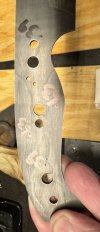ScarFoot
Knifemaker / Craftsman / Service Provider
- Joined
- Sep 16, 2021
- Messages
- 860
I heat treated some blades last week and finally got them cleaned up and ready for hardness testing over the weekend. This was the first time I used an anti-scale compound (atp-641) and think it might have caused issues with the heat treat. I diluted it down somewhere around 3:1-4:1 water:atp and dipped the blades (sanded to 280 grit) after they had been heated to 190F. I left them submerged for 15-20 seconds and let them drip off once removed then dried them with a heat gun. After that they cured for 2 days until heat treat. I got complete coverage on all blades. The layer was so thin I really didn’t think it would survive until I heat treated. You could rub it off with your finger tip. I was heat treating 3 different types of steel: 1095, W2, & 80CrV2 all of which I have used before and all purchased from NJSB. While I was cleaning up the 1095 and W2 after heat treat I noticed an odd hamon effect on some of the blades. I assumed it to be decarb and ground a little more off to no avail. I took 0.025”-0.030” off of each side of one and it was still there. Hardness testing confirmed what I suspected which was that those two steels didn’t fully harden. I got anywhere from 39-64 HRC…on the same blade I ground until I was absolutely confident it wasn’t decarb. I etched it after I got home to make the areas in question stand out. A couple others tested all over the place so obviously I don’t trust any of the 1095 or W2 blades in their current state. The only thing I did different this time was the anti-scale. One thing that stood out was that everything I read said the anti-scale generally flakes off during quench but that didn’t happen on any of mine. It stayed on for the most part until I sanded it off.
My heat treat process for the 1095 and W2 is as follows and all blades were made via stock removal, none were forged:
1. Oven heated to 1465F confirmed with second thermocouple.
2. blade placed in oven and once temperature has come back to 1465 I soak for 10-15 minutes depending on thickness.
3. Quench in Parks 50 (leave blades completely submerged until cool enough to handle with work gloves.) Oil temp averages around 100F.
4. Straighten if needed.
5. Place in 300F oven for snap tempering.
6. Tempered at 405F for 2 hours then cooled to room temp then tempered again at 405F for 1.5 hours.
I normally get around 60-61 HRC with this recipe.
Cleanup for hardness testing was done with SGA. Ground at least 0.015” or more per side and went to 400 grit finish. Sanded some to 600 grit on surface plate and buffed them. All were flat and parallel to within 0.001”. I also checked the hardness tester against 3 test blocks and it measured within 0.1-0.2 HRC of each.
So the question is, could that thin layer of anti-scale have caused all this chaos or am I missing something? Had it only been only one of the steels I would have thought it was just an issue with that batch of steel but I had the same issue with 2 similar steels. The 80CrV2 came out to 60-61HRC on every blade and was probably the most consistent hardness measurements I’ve seen so far. I’m going to run the 1095 and W2 again minus the anti-scale and see what happens.

My heat treat process for the 1095 and W2 is as follows and all blades were made via stock removal, none were forged:
1. Oven heated to 1465F confirmed with second thermocouple.
2. blade placed in oven and once temperature has come back to 1465 I soak for 10-15 minutes depending on thickness.
3. Quench in Parks 50 (leave blades completely submerged until cool enough to handle with work gloves.) Oil temp averages around 100F.
4. Straighten if needed.
5. Place in 300F oven for snap tempering.
6. Tempered at 405F for 2 hours then cooled to room temp then tempered again at 405F for 1.5 hours.
I normally get around 60-61 HRC with this recipe.
Cleanup for hardness testing was done with SGA. Ground at least 0.015” or more per side and went to 400 grit finish. Sanded some to 600 grit on surface plate and buffed them. All were flat and parallel to within 0.001”. I also checked the hardness tester against 3 test blocks and it measured within 0.1-0.2 HRC of each.
So the question is, could that thin layer of anti-scale have caused all this chaos or am I missing something? Had it only been only one of the steels I would have thought it was just an issue with that batch of steel but I had the same issue with 2 similar steels. The 80CrV2 came out to 60-61HRC on every blade and was probably the most consistent hardness measurements I’ve seen so far. I’m going to run the 1095 and W2 again minus the anti-scale and see what happens.



